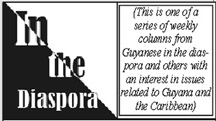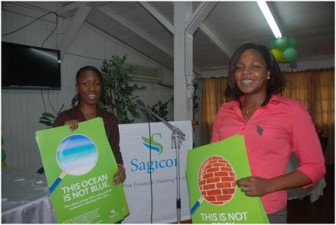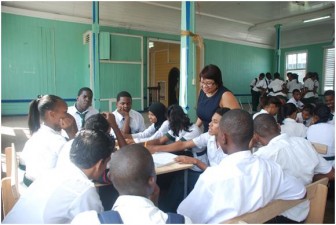Maya Trotz grew up in Kitty, Georgetown and is an Associate Professor of Civil and Environmental Engineering at the University of South Florida.
By Maya Trotz

1. Boost institutional capacity in STEM in the secondary schools in the Challenge Countries.
2. Ignite interest among Caribbean youth for innovation in STEM to help build and integrate sustainable communities throughout the Caribbean.
3. Integrate knowledge gained from formal and informal education to enable tomorrow’s leaders to build a more sustainable Caribbean

As a member of the governing council of the CSF (http://www.caribbeanscience.org) and its first visiting scientist in Barbados, I have been involved with this project from its inception and am truly inspired by the commitment of all entities involved to mainstreaming STEM and sustainability with young people. For this year’s competition the challenge countries include Anguilla, Antigua and Barbuda, Barbados, Belize, Cayman Islands, Dominica, Grenada, Guyana, Jamaica, Montserrat, Saint Kitts and Nevis, Saint Lucia, Saint Vincent and the Grenadines, and Trinidad & Tobago. We are currently working with the various Ministries of Education to run workshops with science and mathematics teachers that better prepare them for the challenge. To date, we have conducted workshops with teachers from Trinidad and Tobago, Guyana, Barbados, Anguilla, and Antigua. Over the next month our team will be presenting in St Kitts (October 22nd), St. Lucia (October 24th), Belize (October 25th), and St. Vincent (November 8th). We have also interacted directly with high schools in Antigua, Trinidad and Tobago and Guyana and are figuring out how to do more of that as we continue to spread the word about this challenge.
In Trinidad and Tobago we visited Waterloo Secondary in Carapichaima where students from second to sixth form quickly understood the challenge. Working in groups under the supervision of staff from Sagicor and a fellow Civil and Environmental Engineering professor Dr. Kiran Tota-Maharaj, they presented creative solutions to cool their classrooms, relieve traffic congestion at the school, and develop more activities for physical exercise. For example, one group proposed composting food waste from the school’s cafeteria to put on a vegetable garden. These vegetables would then be sold to the surrounding community and the money earned would be used to purchase equipment needed to improve sporting facilities. I told the students about current engineering research which looks at making composting more efficient and anaerobic bioreactors that produce energy from food waste that is unsuitable for regular composting. At St. Roses High School in Georgetown, Guyana we worked with science students from fourth to sixth form, some of whom proposed working with the local water authority on testing the water quality of the school’s tap water and designing a system that eliminated the need to purchase bottled water. Plastic waste was a recurring theme throughout our interactions and one of the three examples provided for the challenge proposes a similar shift to water fountains and the elimination of plastic bottled water from school cafeterias. Ms. Anastasia Deonarinesingh, a master’s student in environmental science at the University of the West Indies St. Augustine campus prepared that example which included a survey of students and staff at her hypothetical school along with a cost analysis of installing fountains and selling school oriented reusable water bottles.
The student ideas will form the basis of the school’s entry to the Competition, which will occur in January when the competition launches.

Entries will first be evaluated and judged at the national level in each of the Challenge Countries in February 2013, with the winning school in each country moving on to the regional competition in Barbados. Prizes at the national level for the schools include a CSF Computerized Mobile Science & Technology Centre and CXC approved mini science kits. At the regional level monetary prizes for the schools vary from $1,000 to $5,000 US, and will be given to the top ranked ideas. At both levels, challenge trophies and certificates will be awarded for various categories. Student teams will be matched with mentors who are recruited mainly through the Caribbean Science Foundation. Student representatives and teachers of the winning teams from the national competition will be also participate in an all-expenses-paid STEM Ambassador Program in Florida during Summer 2013. There, Caribbean faculty and professional scientists and engineers will expose them to various STEM/sustainability initiatives. They will also participate in diverse inquiry based STEM learning experiences at places like the Museum of Science and Industry, Disney’s EPCOT center and the Kennedy Space Center.
Trinidad’s own NASA scientist, Ms. Camille Wardrop Alleyne is assisting with the space center visit which we hope includes lunch with an astronaut and a behind the scenes tour. She is an aerospace engineer who is currently an Assistant Program Scientist with NASA’s International Space Station in Texas. She was one of many scientists and engineers who were featured at the kick-off of Sagicor’s ten week National STEM Awareness Campaign for Trinidad and Tobago. Held on Monday October 8th, this all day event targeted high school principals, science teachers, and Sagicor employees. Cardinal Warde, the CSF’s interim executive director and Professor of Electrical Engineering at the #1 ranked university in the world, the Massachusetts Institute of Technology, stressed that the region needs to place more emphasis on engineering as opposed to technology. He argued that engineers create and develop systems, processes, and technologies upon which companies are built, jobs are created, and lives are improved.
The next day, CXC Registrar Dr. Didacus Jules encouraged high school students at the St. Augustine Girls High School to access the CXC website for online learning materials directly linked to the CSEC and CAPE syllabi, and to ‘like’ the CXC facebook page and help build a Caribbean community of online learners. Sagicor’s campaign includes a series of billboards across Trinidad and Tobago that demystify STEM by placing a magnifying glass over common things like cotton, paper, and bricks. One billboard, for example, has an image of a brick, with the words: This is not brick.
This is sand, clay and water, burned at 1000oC. Collis Duranty, a singer whose lyrics resonate with the challenges we face due to urbanism and a disconnect from our surroundings, and who recently shot a wonderful video in Guyana for ‘Earth Song,’ one of his recent compositions on environmental sustainability, performed two songs at the event including the radio jingle that echoes our need for brighter days (you can see the video on his official website, www.collisduranty.com).
In an interview on CTV’s First Up television program in Trinidad and Tobago, co-host Jessie May Ventour asked me how come we don’t see engineers and scientists the way we see musicians and sports figures? I asked her to join our cause and explained that scientists and engineers must work with people in creative arts, marketing and public media if we are to seriously demystify our professions. She was enthusiastic, genuinely concerned, and sent me her number so that I could follow up on engaging her in our mission of mainstreaming STEM and sustainability. As an engineer, working with Sagicor’s marketing teams in Barbados, Trinidad and Tobago, and Jamaica has been intense and totally rewarding. They get that we must collectively do something to ensure that much more than 33% of the young people in the Caribbean receive grades I-III in CSEC’s general mathematics. They get that it is not ok for less than 20% of our young people to be taking science, engineering, and technology subjects at CSEC levels if we are to successfully create a 21st century workforce and sustainable Caribbean communities. And beyond just getting it, they have fully taken on the challenge of changing this discouraging reality and are doing so creatively, strategically, and purposefully. They are also internalizing this challenge and I have no doubt that very soon they will pave the way for large companies in the Caribbean to integrate sustainability into their way of operating.
This is not just a challenge, it is a game changer for sustainable communities and our approach to science, technology, engineering, and mathematics. We really see this as an opportunity to engage local and international communities of all age groups and professions in a fun and meaningful way.
We envision this as a competition for high school students, for teachers, for mentors, for Sagicor’s marketing teams in charge of various countries, for communities, and for entire countries. Please feel free to contact us at info@sagicorvisionaries. org or through our social media site,https://www.facebook.com/sagicorvisionaries. If you are interested in being a mentor to a student team, please directly email me at matrotz@usf.edu.





